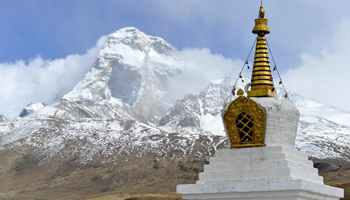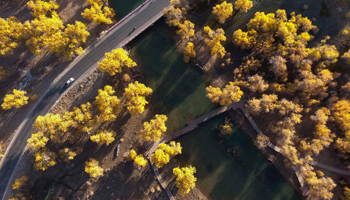HOHHOT, Oct. 16 (Xinhua) -- Ejina Banner, a county which until very recently was virtually unknown in north China's Inner Mongolia Autonomous Region, has clocked up more than 60,000 tourists every day this month, twice the number of its residents.
This boom in tourism is closely linked to the launch of the Shenzhou-11 manned spacecraft, which will blast off at 7:30 a.m. on Monday from Jiuquan Satellite Launch Center in the southwestern part of Ejina.
Within two days of leaving Earth, the spaceship is expected to dock with the orbiting space lab Tiangong-2, which was launched from the same center on Sept. 15.
At dawn Sunday, some keen space fans, weighed down by tents and telescopes, were already setting up camp, readying themselves for the launch after consulting local herdsmen about the best viewing location.
"It will be extremely exciting," said Zhu Xuedong from Beijing. "It's such a rare opportunity."
Home to China's only launch center for manned spacecraft, Ejina has seen an injection of government funding to support the local community and environment, making it increasingly attractive to tourists.
This year, the surface area of Juyanhai Lake, located in the wasteland of Ejina, stood at a 12-year record high of more than 42 square kilometers, after the government in 2000 started to control water use on the upper reaches of the Heihe River that feeds lake downstream.
"The water level has been stable in recent years. There are six fish species living here, with an annual output of 0.8 tonnes," said Altanqeqeg, who runs a lakeside restaurant.
Conservation efforts have boosted growth of the diversiform-leaved poplar, which now covers 440,000 mu (29,300 hectares) of land, up from 390,000 mu in 2000. Meanwhile, the area of desert and wasteland has declined by 39 square kilometers, according to the local forestry bureau.
The improved environment has reduced the havoc often wreaked by the region's notorious sand storms.
"Years ago, I experienced the first sand storm in my life here. Today, all I see are trees. The change is extraordinary," said Xiong Tianhua from southwest China's Sichuan Province.
Before its astral ambitions were set in motion, Ejina was known for the Heicheng ruins, the largest and best preserved ancient city on the Silk Road. It was once the capital of Xixia Kingdom, which disappeared more than 700 years ago.
Archaeologists have been assigned to help protect the site from desert sand and the impact of tourists' visits.
Some herdsmen in Ejina care more about the space launch than others, since some had to move from their ancestral homes to make way for the launch complex.
In 1958, more than 1,400 herdsmen left their homes in the oasis of Ejina along the Heihe River, to make way for the Jiuquan Satellite Launch Center, and embarked on what was to become a nomadic life spanning years.
"That's my hometown. I left with pain, but my sacrifice was worth it," said Oyongerle, 75.










